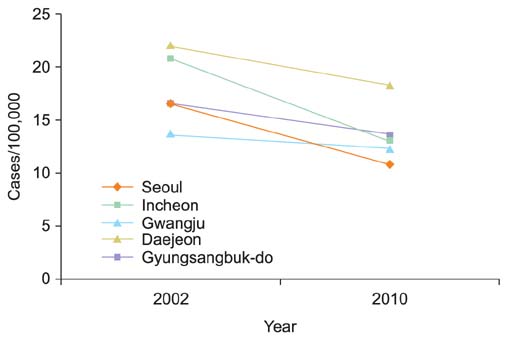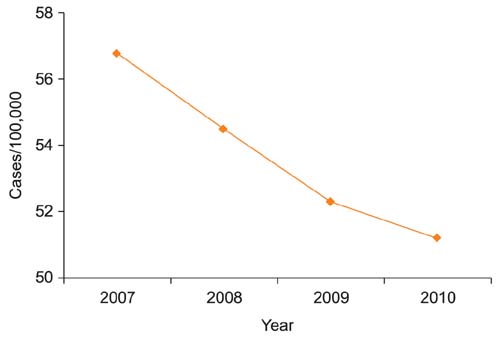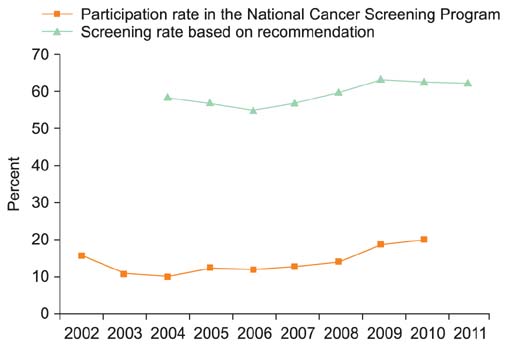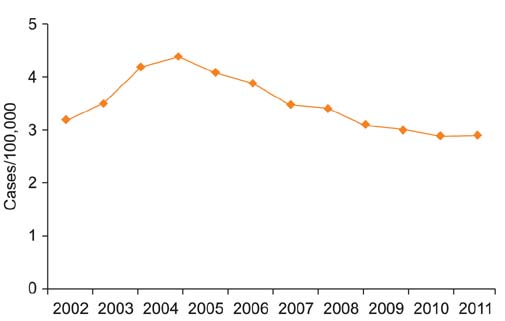Epidemiologic characteristics of cervical cancer in Korean women
- Affiliations
-
- 1Department of Obstetrics and Gynecology, School of Medicine, Kyung Hee University, Seoul, Korea. kgo02@hanmail.net
- KMID: 1811191
- DOI: http://doi.org/10.3802/jgo.2014.25.1.70
Abstract
- Cervical cancer is the most common female genital tract malignancy in Korean women. Although age-standardized cancer incidence rate of cervical cancer has decreased from 18.6 per 100,000 women in 1999 to 12.3 per 100,000 women in 2010 in Korea with widespread routine screening, several epidemiologic characteristics are still present. Incidence of cervical cancer still varies according to geographic area, and a significant portion of cases are detected at a locoregionally advanced stage, without significant improvement of five-year survival rate.2014-01-15 Cervical screening techniques such as the Pap smear should be the gold standard strategy to decrease incidence and to improve the survival outcomes of patients with cervical cancer. In addition, screening programs for cervical cancer should be designed, organized and directed within the context of a nationwide program for cancer control.
Keyword
Figure
Cited by 3 articles
-
Comparison of the PANArray HPV Genotyping Chip Test with the Cobas 4800 HPV and Hybrid Capture 2 Tests for Detection of HPV in ASCUS Women
Eun Young Ki, Yoon Kyung Lee, Ahwon Lee, Jong Sup Park
Yonsei Med J. 2018;59(5):662-668. doi: 10.3349/ymj.2018.59.5.662.The Impact of High-Risk HPV Genotypes Other Than HPV 16/18 on the Natural Course of Abnormal Cervical Cytology: A Korean HPV Cohort Study
Kyeong A So, Mi Jung Kim, Ki-Heon Lee, In-Ho Lee, Mi Kyung Kim, Yoo Kyung Lee, Chang-Sun Hwang, Mi Seon Jeong, Mee-Kyung Kee, Chun Kang, Chi Heum Cho, Seok Mo Kim, Sung Ran Hong, Ki Tae Kim, Won-Chul Lee, Jong Sup Park, Tae Jin Kim
Cancer Res Treat. 2016;48(4):1313-1320. doi: 10.4143/crt.2016.013.Strategic Distributional Cost-Effectiveness Analysis for Improving National Cancer Screening Uptake in Cervical Cancer: A Focus on Regional Inequality in South Korea
Tae-Hoon Lee, Woorim Kim, Jaeyong Shin, Eun-Cheol Park, Sohee Park, Tae Hyun Kim
Cancer Res Treat. 2018;50(1):212-221. doi: 10.4143/crt.2016.525.
Reference
-
1. Jemal A, Bray F, Center MM, Ferlay J, Ward E, Forman D. Global cancer statistics. CA Cancer J Clin. 2011; 61:69–90.2. Parkin DM, Bray F, Ferlay J, Pisani P. Estimating the world cancer burden: Globocan 2000. Int J Cancer. 2001; 94:153–156.3. Lee JM. Screening of uterine cervical cancer in low-resource settings. J Gynecol Oncol. 2012; 23:137–138.4. Statistics Korea. Korean Statistical Information Service [Internet]. Daejeon: Statistics Korea;2012. cited 2013 Apr 30. Available from: http://kosis.kr.5. National Cancer Center. National Cancer Information Center [Internet]. Goyang: National Cancer Center;2012. cited 2013 Apr 30. Available from: http://www.cancer.go.kr.6. Shin HR, Won YJ, Jung KW, Kong HJ, Yim SH, Lee JK, et al. Nationwide cancer incidence in Korea, 1999~2001; first result using the national cancer incidence database. Cancer Res Treat. 2005; 37:325–331.7. Jung KW, Park S, Won YJ, Kong HJ, Lee JY, Park EC, et al. Prediction of cancer incidence and mortality in Korea, 2011. Cancer Res Treat. 2011; 43:12–18.8. Jung KW, Park S, Won YJ, Kong HJ, Lee JY, Seo HG, et al. Prediction of cancer incidence and mortality in Korea, 2012. Cancer Res Treat. 2012; 44:25–31.9. Chung HH, Jang MJ, Jung KW, Won YJ, Shin HR, Kim JW, et al. Cervical cancer incidence and survival in Korea: 1993-2002. Int J Gynecol Cancer. 2006; 16:1833–1838.10. Korean Society of Obstetrics and Gynecology. Annual report of gynecologic cancer registry program in Korean for 1999(Jan. 1, 1999 - Dec. 31, 1999). Korean J Obstet Gynecol. 2002; 45:1665–1699.11. Korean Society of Obstetrics and Gynecology. Annual report of gynecologic cancer registry program in Korea for 2000: Jan. 1, 2000 - Dec. 31, 2000. Korean J Obstet Gynecol. 2003; 46:221–258.12. Korean Society of Obstetrics and Gynecology. Annual report of gynecologic cancer registry program in Korean for 2001 (Jan. 1, 2001 - Dec. 31, 2001). Korean J Obstet Gynecol. 2003; 46:1849–1887.13. Lee MY, Cho CH, Kwon SH, Song DK, Chung SW, Kang HO, et al. Annual report of gynecologic cancer registry program in Korean for 2002 (Jan. 1st, 2002 - 2002 - Dec. 31st, 2002). Korean J Obstet Gynecol. 2004; 47:1029–1070.14. Korean Society of Obstetrics and Gynecology. Annual report of gynecologic cancer registry program in Korea for 2003 (Jan. 1st, 2003-Dec. 31st, 2003). Korean J Obstet Gynecol. 2006; 49:762–812.15. SOG Gynecologic Oncology Committee. Annual report of gynecologic cancer registry program in Korea for 2004 (Jan. 1st, 2004-Dec. 31st, 2004). Korean J Obstet Gynecol. 2007; 50:28–78.16. NHS Cancer Screening Programmes. NHS cervical screening programme: annual review 2009. Sheffield: NHS Cancer Screening Programmes;2009.17. National Cancer Institute. Cancer trends progress report: 2010/2011 update [Internet]. Bethesda, MD: National Cancer Institute;c2013. cited 2013 Jun 19. Available from: http://progressreport.cancer.gov.18. Lee YH, Choi KS, Lee HY, Jun JK. Current status of the National Cancer Screening Program for cervical cancer in Korea, 2009. J Gynecol Oncol. 2012; 23:16–21.19. National Health Insurance Service, Health Insurance Review & Assessment Service. 2011 National Health Insurance statistical yearbook. Seoul: National Health Insurance Service, Health Insurance Review & Assessment Service;2012.20. Singh GK, Miller BA, Hankey BF, Edwards BK. Persistent area socioeconomic disparities in U.S. incidence of cervical cancer, mortality, stage, and survival, 1975-2000. Cancer. 2004; 101:1051–1057.21. National Cancer Institute. Surveillance epidemiology and end results cancer statistics review 1975-2010 [Internet]. Bethesda, MD: National Cancer Institute;c2013. cited 2013 Jun 19. Available from: http:// seer.cancer.gov.22. Kachuri L, De P, Ellison LF, Semenciw R. Advisory Committee on Canadian Cancer Statistics. Cancer incidence, mortality and survival trends in Canada, 1970-2007. Chronic Dis Inj Can. 2013; 33:69–80.23. Matsuda T, Ajiki W, Marugame T, Ioka A, Tsukuma H, Sobue T, et al. Population-based survival of cancer patients diagnosed between 1993 and 1999 in Japan: a chronological and international comparative study. Jpn J Clin Oncol. 2011; 41:40–51.
- Full Text Links
- Actions
-
Cited
- CITED
-
- Close
- Share
- Similar articles
-
- Epidemiologic report of gynecologic cancer in Thailand
- The Increasing Frequency of Cervical Cancer in Korean Women under 35
- Causes and Diagnoses of Cervical Cancer
- Study on Numbers of Cervical Cytology before Diagnosis of Cervical Cancer and Cervical Intraepithelial Neoplasia
- Cervical cancer in Thailand: 2023 update






